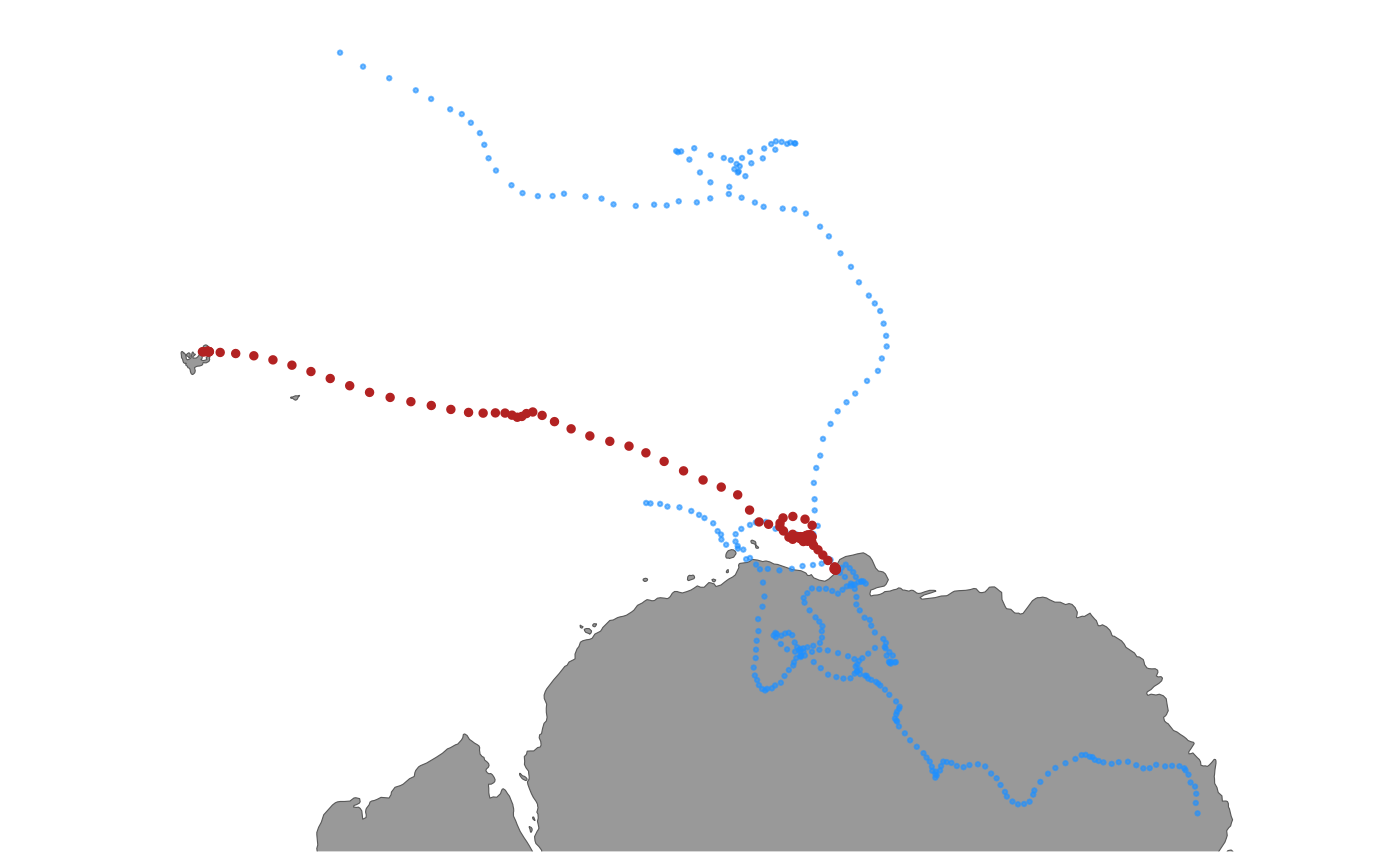simulate from the rw or crw process models to generate
either a set of x,y or lon,lat coordinates from a ssm fit with length
equal to the number of observations used in the SSM fit.
Arguments
- x
a
ssmfit object with classssm_df- what
simulate fitted (typically irregular in time) or predicted (typically regular in time) locations
- reps
number of replicate tracks to simulate from an
ssmmodel fit object- start
a 2-element vector for the simulated track start location (lon,lat or x,y)
- end
a 2-element vector for the simulated track end location (lon,lat or x,y)
- grad
a SpatRaster of x- and y-gradients as separate layers (see details)
- beta
a 2-element vector of parameters defining the potential function magnitude in x- and y-directions (ignored if
is.null(grad), ie. no potential function; see details).- cpf
logical; should simulated tracks return to their start point (ie. a central-place forager)
- sim_only
logical, do not include
ssmestimated location in output (default is FALSE)
Value
a fG_sim_fit object containing the paths simulated from a
ssm fit object
Details
A potential function can be applied to the simulated paths to help
avoid locations on land (or in water), using the grad and beta
arguments. A coarse-resolution rasterStack of global x- and y-gradients of
distance to land are provided. Stronger beta parameters result in stronger
land (water) avoidance but may also introduce undesirable/unrealistic artefacts
(zig-zags) in the simulated paths. See Brillinger et al. (2012) and
vignette("momentuHMM", package = "momentuHMM") for more details on the
use of potential functions for simulating constrained animal movements.
WARNING: This application of potential functions to constrain simulated
paths is experimental, likely to change in future releases, and NOT guaranteed
to work enitrely as intended, especially if cpf = TRUE!
References
Brillinger DR, Preisler HK, Ager AA, Kie J (2012) The use of potential functions in modelling animal movement. In: Guttorp P., Brillinger D. (eds) Selected Works of David Brillinger. Selected Works in Probability and Statistics. Springer, New York. pp. 385-409.
Examples
fit <- fit_ssm(ellie, model = "crw", time.step = 24)
#> fitting crw SSM to 1 tracks...
#>
pars: 1 1 0 -2.91153
pars: 0.38512 0.37191 -0.01692 -3.38813
pars: -1.4595 -1.51236 -0.06769 -4.81792
pars: -2.20058 -2.24383 -0.11527 -4.95732
pars: -0.38346 -0.4056 -0.04615 -3.85456
pars: -1.23664 -1.20844 -0.10327 -3.65984
pars: -2.25711 -2.16871 -0.17159 -3.42693
pars: -3.07868 -3.34599 -0.26131 -1.24778
pars: -4.46619 -1.62751 -0.49092 0.12579
pars: -3.18442 -2.86245 -0.30197 -0.80151
pars: -3.40955 -3.30581 -0.49919 -0.40195
pars: -3.06893 -3.16418 -1.05454 -0.36585
pars: -3.5513 -2.81435 -1.34642 -0.44033
pars: -3.30092 -3.01944 -1.10395 -0.39263
pars: -3.27833 -3.03821 -1.38152 -0.39631
pars: -3.23173 -2.97174 -2.21731 -0.40477
pars: -3.28771 -3.08271 -5.28966 -0.34232
pars: -3.30222 -3.07091 -5.31779 -0.38305
pars: -3.30222 -3.07091 -5.31779 -0.38305
trs <- sim_fit(fit, what = "predicted", reps = 3)
plot(trs)
